Education
Nature Kindergartens
Claire Warden explores an example of a nature kindergarten in Scotland in order to stimulate discussion around what a nature-based model in India might look like.
Published
6 years agoon
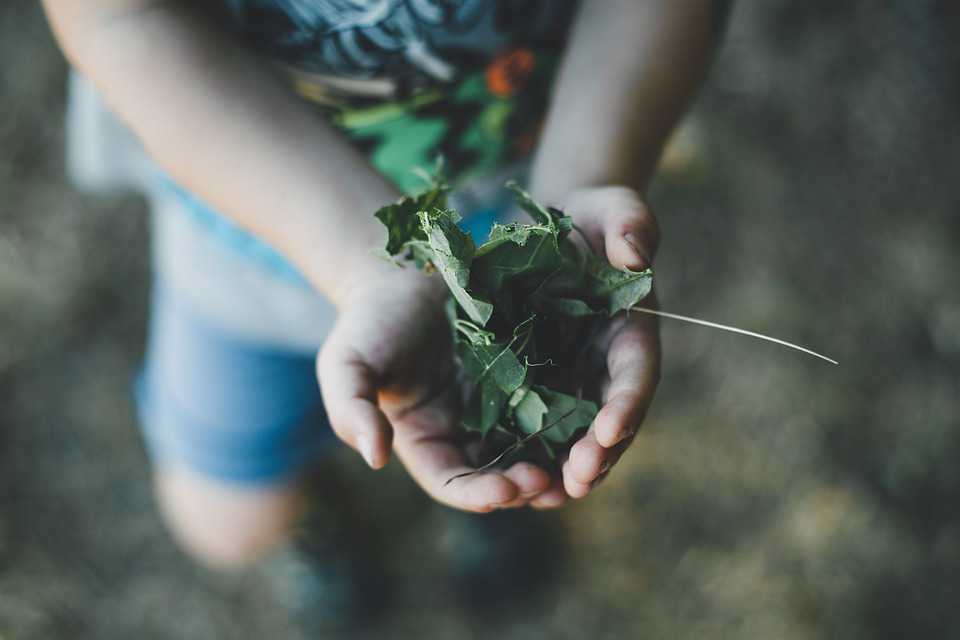
A nature kindergarten is a model of early years education that has evolved through Germanic and Scandinavian traditions of outdoor nurseries for children from 2 to 5 years old. However, there are also many other models of nature-based education we can explore that embrace the same underlying values of nature pedagogy (Warden 2018), but which are culturally and climatically situated in other parts of the world. This article explores an example of a nature kindergarten in Scotland in order to stimulate discussion around what a nature-based model in India might look like.
In 2006, Mindstretchers founded the first nature kindergarten in Scotland. It was called Whistlebrae and operated as a site of innovation to drive change in people’s awareness and understanding of nature-based models of early education. It developed conversations with the authorities responsible for licencing early education and care by providing a tangible context for those conversations; it drew people from across the globe to see and feel how a nature kindergarten model operated; it provided a situation to engage in dialogue to determine which educational models may be culturally relevant to Scotland; and it provided a framework for professionals to question and explore the values and beliefs in the pedagogy of practice – a process which ultimately became my PhD in nature pedagogy.
Throughout the world, there have always been people who place nature centrally to their lives, and now the number of educational settings that embrace the teachings of the natural world in their day-to-day practice has increased to a level that is growing exponentially. There are many different types or models of settings that are nature-based and they have evolved in their own cultural locations and are therefore affected by climate and curriculum. They have a wide range of names, such as Schogsmulle (Sweden); Barneharge (Norway); Waldkindergarten (forest kindergarten in Germany); Nature kindergartens (UK); Nature pre-schools (USA), but they all provide children with immersive experiences in the natural world. All of these settings share a connection and similarity in their work, in that they embrace the values of nature pedagogy (Warden 2011, 2015, 2018). I define nature pedagogy as a relational pedagogy that embraces the art of being with nature inside, outside and beyond (2018: 2).
When nature pedagogy is fully embedded in practice, it is manifested as a way of working with children and families that creates settings for care and education that embrace nature and place it at the heart of their values. Its impact is all-encompassing, from the biophilic educational environments, to the child-centred process of assessment and planning, through to the active learning journeys that we encourage children and families to take to support the children to be sustainable in their thoughts and actions (Warden 2012:7). The range of models around the world can be placed along a continuum of practice based on the amount of time they spend in contact with the natural world in their day-today practice. Our definition of a nature kindergarten is that it sits at the end of the continuum where nature pedagogy is integrated into everything, in order to create a sustainable way of educating children that brings together the health of the mind, body and spirit with education and the need to teach skills, concepts and knowledge. Models such as forest school or nature clubs are more reductionist, as only blocks of time are spent in the forest, rather than fully embracing a pedagogy for day-today living and learning. In practice that means that our current nature kindergarten, Auchlone Nature Kindergarten, is the manifestation of our nature-based, pedagogical values of love, hope and justice. We support place-based learning as it gives us cultural identity and a history-making potential that is valued by children and families.
The programming is mindful of children’s authentic experiences across three nominal spaces to ensure connection and relevance – inside the setting, outside in the outdoor area and beyond the fence to learn with the community and natural landscapes around the setting. The Auchlone site has a homestyled inside area in a 19th Century stone house; and a landscape designed by children with hills, sandcastle, hiding spaces, small pond and mud area. This links seamlessly to the area beyond the fence where the natural landscape of fields and forests exists on nature’s terms, not cleaned up, ordered or tidied. At Auchlone, children can be outside 70-100% of the time all year round, five days a week if they want to be. The staff are trained to work inside or outside. Given the damp climate here in Scotland, we sometimes settle in an open-fronted kinder kitchen that allows daily cooking, provides warmth from a log stove and light from a child-created, stick candelabra. It is in this space, where we stay in our outdoor clothes, that we develop a real sense of community, resting after a strenuous walk or sharing our tales of risk and adventure.
There are many routines that are often the backbone of our daily and seasonal rhythms – collecting wood for the fire, harvesting food, making our felt slippers, packing backpacks for our journeys, designing and making forts and shelters and celebrating the joy and love of it all through story, song, writing, drawing and making artefacts.
The planning and programming of the nature kindergarten model stems from social constructivism, where we create a balance of adult intentionality with children’s voices and theories. We use Participatory Planning through Floorbooks (Warden 1996) to combine four voices. The first is to raise and honour children’s voices; the second is the voice of the natural world as an authentic context, the third is the professional analysis which tracks the learning journey that evolves over time; and the fourth is the parent or carer who creates a link from the home to the education setting. Given that nature pedagogy embraces the natural world, we use the elements of Fire, Earth, Air and Water to guide our fascinations and project inquiries. This lends itself easily to science, technology, engineering, arts and mathematics (S.T.E.A.M.), as many great thinkers, such as Edison, took inspiration from the natural world.
There are those who suggest that there is an unrealistic, romantic notion of childhood and nature that we seek to support in a nature kindergarten. My research (Warden 2018) suggests that although childhoods are indeed situated and complex, there is a purity in the moment where a child studies a worm or is fascinated by water droplets on a leaf, that exists below these larger cultural worlds. The unspoken question is around whether these models of nature immersion, such as nature kindergartens, are relevant in other climates and cultures, and do they have relevance in the urban landscapes where many of us live.
The answer lies in our understanding of the pedagogical values, not simply a site or name, but in the interconnectedness all the models have with nature pedagogy. An experience that uses nature as the context for learning inside or outside; a setting that seeks to be sustainable by embracing holistic learning of the mind, body and soul; a place that allows children to connect to animals and plants on a regular basis; an environment that embraces biophilic design in the décor – these aspects are not about the sites but about the situations we want to encounter. A flower vase on a children’s dining table, gentle tones of colour in the furnishings, images of the natural world on the walls, the sound of birdsong inside – all have a positive effect on the emotional wellbeing of young children, as well as the intellectual and physical benefits they offers. This is the holistic world of nature pedagogy and it can be applied anywhere.
Adults are key to the quality and intentionality of the education of young children. Auchlone Nature Kindergarten has received the highest ratings from the Scottish inspectorate for care and education. As an educational entrepreneur, my focus was to achieve this status so people could clearly see evidence that children could engage in high quality learning outside the walls of a setting. This quality of interaction was achieved through staff training in nature pedagogy that supports them to understand and connect to how to learn with nature, rather than just being in it, or learning about it. The pedagogy and landscape have become intertwined in a way that they work seamlessly together. Children and families feel this when they come to be with us – it’s a relational pedagogy that places value on all living and non-living aspects of the natural world. The staff/child ratios we work with are 1:8 for 3- to 5- year-olds and this doesn’t alter across the three spaces unless we are near water, as we don’t perceive there to be more hazards outside, in fact the reverse is normally the case!
We have built on Gill’s (2007) work, so that the risk management process records children’s voices and their ideas as the stake holders, and includes dynamic risk assessments that change daily and residual risk assessments that are written up for the site itself and the experience offered. Rather than risk assessments preventing adventure, we suggest that they enable us to think collectively as a team and therefore support us to give children the freedom they seek.
The physicality and complexity of the nature kindergarten model allows the body, brain and soul to grow. The range of simple materials provides complex learning through a range of provocations that authentically emerge from the context. The potential of nature’s store cupboard has been celebrated by theorists such as Montessori, Froebel and Pestalozzi, who give us a framework to understand the place of nature in children’s lives.
There is a rising interest in naturebased models of early education around the world. However, rather than impose one possibly inappropriate model on top of a culture context, it is vital to create place-based models that draw on culture and context to shape and define them, whilst holding onto core values and guiding principles that connect us as a profession. My husband and I founded a charity in 2010 called Living Classrooms, which was designed to bring learning alive for marginalised groups. This now runs the International Association of Nature Pedagogy, which is a free professional association that seeks to connect practitioners globally who believe in nature-based practices. The focus has tended to be towards Germanic and Scandinavian immersion models, such as nature kindergartens or forest schools, however there are many, many ways of engaging with the natural world that are rooted in Indigenous pedagogies or other cultures that embrace different ways of knowing and being with the natural world. The association seeks to embrace rather than segregate people into separate silos defined by names, and to connect them through debate and research about how to learn with nature, hence the term nature pedagogy.
When we view nature pedagogy as a way of being with nature, we can start with whatever nature we can access. It may be the park, the vegetable stall at the market, the weed in the pavement – it all has potential for learning. It is how we enter a relationship with it, to care about it, to respect it, to gather it in a sustainable way, to understand the natural world, that is the key to raising it as an invaluable element of the learning process. It is this relationship that lies at the heart of models of nature immersion, such as nature kindergartens, so it can take place anywhere – urban or rural, hot or cold, wet or dry!
International consultant Claire Warden is Director Mindstretchers, Founder Living Classrooms Charity and International Association of Nature Pedagogy.
You may like
-
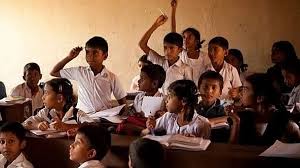

UP Govt Launches Astro Labs in Government Schools to Boost Scientific Learning
-
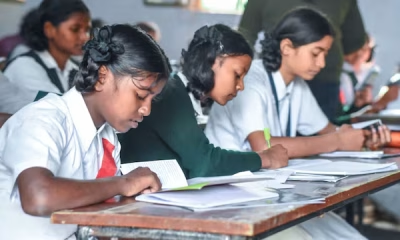

Class 3 Learning Levels Show Gains Since Pandemic, But Still Below 2017: PARAKH Survey
-
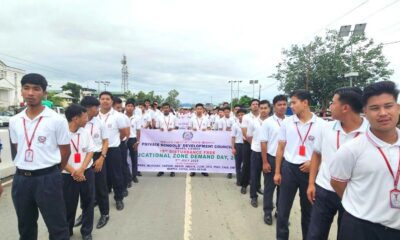

Manipur Rallies Call for Disruption-Free Education Amid Ongoing Unrest
-
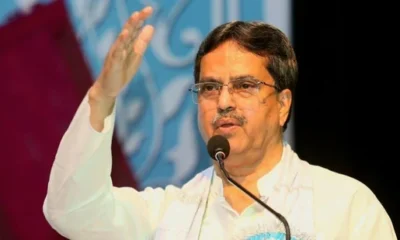

Tripura CM Launches School Framework, Stresses Social Work in Education
-
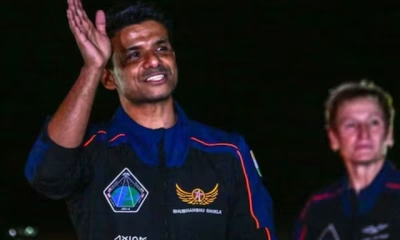

“We Sleep on Walls Here”: Shubhanshu Shukla Talks to Indian Students from Space
-


A Structural Proposal to Transform School Education in Bihar
-


NIIT Foundation and YuWaah, UNICEF Launch Free Online Digital Marketing Course for Youth
-


National Conference Pushes for Common Standards Across School Boards
-
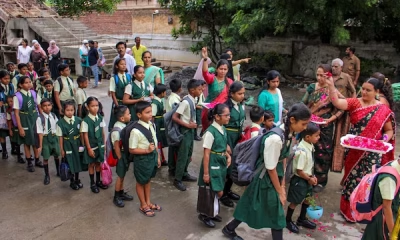

Maharashtra: Over 8,000 Villages Lack Schools, CCTV Compliance Still Patchy
-
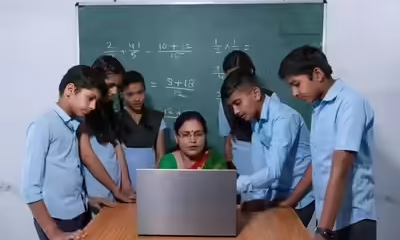

Haryana to Offer Free After-School Coaching for JEE, NDA Aspirants
Education
UP Govt Launches Astro Labs in Government Schools to Boost Scientific Learning
Published
1 day agoon
July 8, 2025
Under the leadership of Chief Minister Yogi Adityanath, the state is rolling out astro labs in government schools at the block level, aiming to strengthen scientific thinking and curiosity among school children, especially in rural areas.
According to a statement issued by the government, these labs—named Amrit Kaal Learning Centres—are being developed through a public-private partnership (PPP) model and are already operational in several districts.
The initiative is designed to give students access to real-time, hands-on learning experiences using tools like Dobsonian telescopes, VR headsets, microscopes, light experiment kits, and anatomical models. These tools go beyond textbook learning, allowing students to explore astronomy, gravity, light, and the physical world through direct experimentation.
Officials say the initiative has already made significant impact. In Ballia district, for example, science labs have been established in all 17 blocks to make science more engaging and inquiry-driven.
Ballia District Magistrate Mangla Prasad Singh said the labs are aligned with the state’s broader goal of making science accessible and meaningful. “These labs are designed to foster experiential and inquiry-based learning,” he noted.
Chief Development Officer Aojaswi Raj added that each lab costs between ₹2.5 to ₹3 lakh, including both the equipment and teacher training. The inclusion of orientation sessions, video guides, and mentorship support for teachers ensures that the labs are used effectively in classrooms.
“These labs have sparked genuine curiosity among children, who now ask questions, observe the night sky, and explore concepts far beyond the standard curriculum,” said Raj.
The program is part of a larger effort to bridge the gap between urban and rural education. With access to advanced tools and teacher support, children in villages are beginning to imagine careers in space science, inspired by stories like that of Indian-origin astronaut Shubhanshu Shukla.
The UP government hopes this initiative will help build a future-ready generation, where aspiration is not defined by geography, and the boundaries of scientific exploration begin right from the classroom.
Education
Class 3 Learning Levels Show Gains Since Pandemic, But Still Below 2017: PARAKH Survey
Published
1 day agoon
July 8, 2025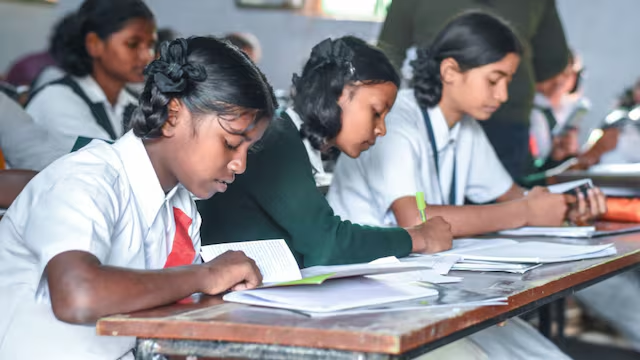
According to the government’s latest PARAKH Rashtriya Sarvekshan report released on Monday, Class 3 students across India have yet to return to pre-COVID academic levels. The survey, conducted in December 2024, covered more than 21 lakh students from Classes 3, 6, and 9 across 74,229 schools, offering a large-scale snapshot of student learning recovery after the pandemic.
Among the three grades, Class 3 is the only one surveyed in all three rounds (2017, 2021, and 2024) — allowing for direct comparison. While there has been an uptick in scores since the 2021 assessment, they remain below the national average recorded in 2017.
In 2024, Class 3 students scored an average of 64% in language, compared to 62% in 2021 — but still lower than 66.7% in 2017. In Mathematics, the score stood at 60%, up from 57% in 2021, but below the 63% recorded in 2017.
Students were found to struggle the most in reading short stories and understanding them (60%), while performing best in everyday language usage (67%). In Maths, the lowest scores came in geometry and money concepts (50%), with the strongest performance in identifying basic shapes and number patterns (69%).
The survey’s structure is aligned with the National Education Policy (NEP) 2020, which breaks school education into four key stages. Class 3 marks the end of the Foundational Stage, making it a crucial checkpoint for basic literacy and numeracy.
Classes 6 and 9: Scores Below 50% in Most Subjects
Students in Classes 6 and 9 showed average scores below 50% in all subjects except language, suggesting that older cohorts may be bearing the brunt of prolonged learning loss from pandemic-related school closures.
A senior official from the Ministry of Education noted that these grades missed nearly two full years of classroom instruction during a critical developmental period. Despite visible recovery since 2021, the learning gaps persist.
Why This Matters
The findings serve as a reminder of the lasting impact of the pandemic on India’s school education, especially for early learners. The report calls for targeted learning interventions, curriculum adjustments, and robust teacher support systems to help students recover foundational skills.
With only limited time before students transition into higher stages of schooling, the emphasis is now on accelerated catch-up strategies and deeper diagnostic assessments to address these persistent gaps.
Education
Design and the Future of Learning: How Architecture is Shaping Next-Gen Schools
Published
1 day agoon
July 8, 2025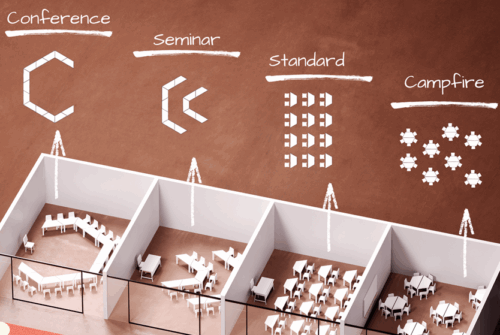
Schools Undergoing Change in India
Schools in India are undergoing a major transformation. Teaching methods are evolving, and schools must meet rising expectations from students, parents, and educators. The National Education Policy (NEP) 2020 has introduced a fresh approach to learning, making it essential for new schools to be designed with these ideas in mind. Older campuses also need thoughtful upgrades and renovations to keep pace.
Schools must adapt to stay relevant in the years ahead. Designing flexible, future-ready spaces is no longer optional, it is vital for creating learning environments that will serve new generations for decades to come.
Experiential Learning
Experiential learning is reshaping education by focusing on hands-on, experience-based learning. It encourages students to take part in activities, real-world problem-solving, and interactive projects that spark curiosity and innovation. Collaboration is central — students work together to tackle challenges, share ideas, and find solutions. This approach deepens understanding and builds teamwork and communication skills needed for future work.
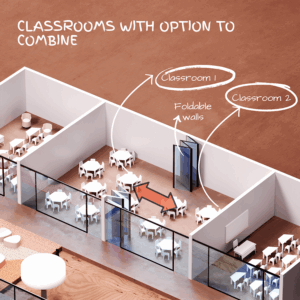
The Importance of Collaboration
Creating spaces that foster experiential learning, enhance engagement, and build critical thinking is essential. Collaborative spaces are a core part of modern school design. They encourage active learning and help students grasp concepts in a deep and meaningful way. By fostering collaboration, schools enable students to develop the skills necessary for success in a rapidly changing world.
Evolving Traditional Classrooms
Traditional classrooms are changing fast. The old rows of desks facing the teacher are giving way to flexible layouts that support different ways of learning. Today’s classrooms can easily switch between standard seating for lectures, conference-style setups for group work, seminar formats for presentations, or campfire circles for open discussions.
Good spatial design plays a big role in building critical thinking and problem-solving skills. A well-designed classroom makes it easy to rearrange furniture for each activity, helping students engage more, think creatively, and learn better together. Studies show students are more motivated and focused in classrooms that adapt to different teaching styles and make learning more interactive.
Spatial Design to Encourage Collaboration
Classrooms with movable furniture allow easy reconfiguration for group work, individual study, or interactive discussions. Flexibility is crucial in modern school design, with modular furniture, movable walls, and multipurpose rooms adapting to different needs. Removing long corridors and creating learning commons with classrooms around them is another innovative approach. Classrooms can open into these commons using sliding or folding partitions, creating a cohesive learning environment. Combining classrooms allows teachers to teach multiple groups together,
building a sense of community.
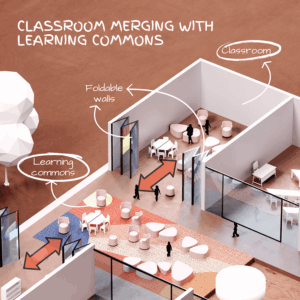
Breakout spaces offer small areas for group discussions, brainstorming, or quiet study, with comfortable seating and whiteboards. Makerspaces equipped with tools and materials foster innovation and hands-on learning by allowing students to apply theory in practice. Outdoor learning areas like gardens or amphitheaters add variety and encourage creativity. Technology-integrated spaces with interactive whiteboards and projectors enhance collaboration by making it easy for students to work together and share ideas. Learning pods provide semi-private spots for group work or individual study. Transparent walls and large windows create openness and bring in natural light, inspiring students to stay engaged.
Designing for well-being & Inclusion
Natural light, vibrant colours, and good acoustics make learning spaces more engaging. Inclusivity is essential so that diverse needs and abilities are accommodated, ensuring all students can succeed. Cross ventilation, thermal comfort, and indoor air quality are equally important — they improve physical comfort and well-being, helping students focus better.
Creativity is also key in effective learning spaces. From preschools to K-12, classrooms should inspire imagination and encourage students to think beyond the ordinary. Thoughtful design elements help create environments where curiosity and innovation thrive.
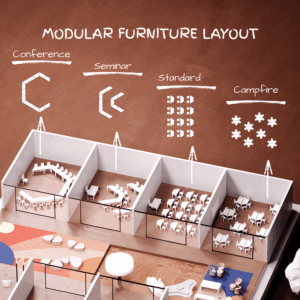
Conclusion
The future of learning will continue to evolve, but well-designed spaces will always play a central role. As educators and designers, we have a unique responsibility to create environments that inspire curiosity, spark ideas, and
support every learner’s journey. By designing schools that are flexible, inclusive, and future-ready, we build not just better classrooms but a stronger foundation for generations to come.
This article is authored by Vinod and Ranju Singhi, the Co-Founders and Principal Architects of BASICS Architects.
Education
Punjab to Introduce Business, Marketing Education in Govt Schools for High Schoolers
Published
2 days agoon
July 7, 2025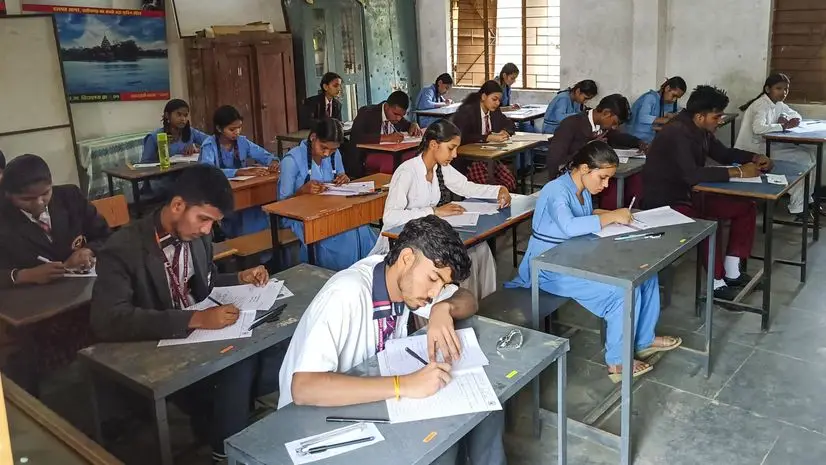
The Punjab government has announced that all Class 11 and 12 students in government schools will receive skill education in business and marketing from the upcoming academic session. The initiative is being implemented under the Punjab Young Entrepreneurs Scheme.
According to Education Minister Harjot Singh Bains, the programme aims to introduce basic entrepreneurship concepts to senior secondary students. As part of this, students will be required to develop and present business ideas as subject-linked projects. The state has also invested in setting up innovation labs in schools to support product development and technical training.
The initiative was formally presented at the Business Blasters Expo 2025, where student teams from various districts showcased business models to a panel of educators, industrialists, and startup professionals. According to official information, participating teams received financial support to take their ideas forward.
Some of the student-led projects included products such as handmade goods, natural cosmetics, customised simulators, framed artwork, and cycle-based mobility solutions. In one case, a student from Mullanpur Dakha created decorative items that were later sold in the market at a significantly higher margin.
The Education Minister also cited employment data between 2014–15 and 2021–22, pointing to a gap between job applicants and job placements. The scheme, he said, is being introduced with the aim of equipping students with skills relevant to today’s economic landscape.
Initially piloted in 30 schools, the Punjab Young Entrepreneurs Scheme is now being scaled across the state. The business and marketing module is expected to cover financial literacy, product development, market analysis, and customer outreach.
The government has stated that the curriculum will align with academic requirements while also supporting practical exposure. Further partnerships with technical institutions and industry stakeholders are also being explored.
Education
Manipur Rallies Call for Disruption-Free Education Amid Ongoing Unrest
Published
2 days agoon
July 7, 2025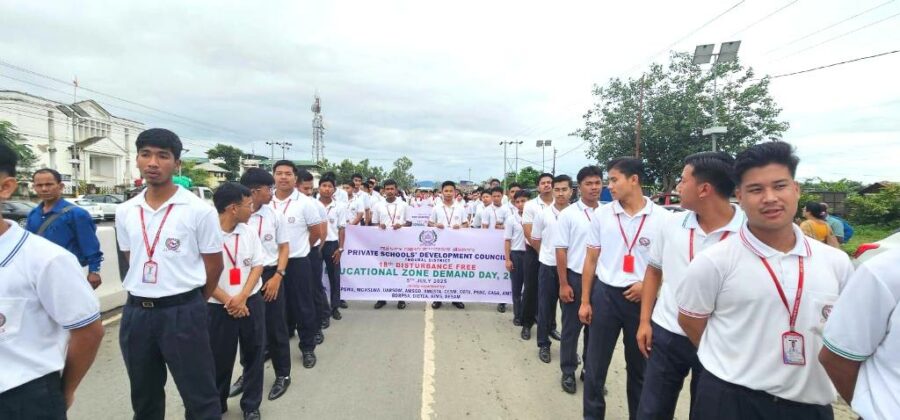
Thousands of voices echoed across the valley districts of Manipur on 5th July, as students, teachers, and civil society members marched in unison, demanding an uninterrupted and safe educational environment. Marking the 18th Disturbance-Free Education Zone Demand Day, the rallies were spearheaded by the Democratic Students’ Alliance of Manipur (DESAM), with support from over 15 civil society organisations.
Held across Imphal East, Imphal West, Kakching, Thoubal, and Bishnupur, the rallies were unified under the message: “Make Education a Disturbance Free Zone.” From THAU Ground near the Legislative Assembly to Imphal College, and similar routes in other districts, demonstrators walked with banners, placards, and resolute slogans calling for peace and protection of learning spaces.
This year’s observance comes at a particularly sensitive moment for the state, as Manipur continues to reel from over two years of ethnic conflict, political instability, and administrative disruptions. These challenges have had a disproportionate impact on the state’s education system—schools in conflict zones have been intermittently closed, exams postponed, and many children displaced from both their homes and classrooms.
Speaking to the media during the rally, DESAM President Mayengbam Somorjit urged the government to pass legislation mandating a minimum of 220 academic days per year, to ensure stability and learning continuity even during crises. He emphasized that children in Manipur must not be deprived of their right to education because of circumstances beyond their control.
Other demands included the appointment of Directors of Education from among experienced educators, and greater transparency in recruitment and promotion processes within the education department. There were also strong appeals to armed groups to abstain from placing financial or material demands on educational institutions—a practice that has led to school closures and security concerns in the past.
The rallies were largely peaceful and drew significant participation from both urban and rural communities. Protesters stressed that beyond political resolution, restoring education must become a humanitarian priority.
In the past two years, students in conflict-affected districts have faced regular school closures, sporadic internet blackouts, and mental health challenges, as families grapple with violence, displacement, and uncertainty. NGOs and local educators have warned of rising dropout rates, learning loss, and a deepening digital divide—especially in remote or vulnerable communities.
While the larger political crisis in Manipur continues to seek resolution, the message from students and educators is clear: education must be safeguarded. As one banner read during the march: “Books, not bullets. Peace, not pauses.”
Education
Tripura CM Launches School Framework, Stresses Social Work in Education
Published
2 days agoon
July 7, 2025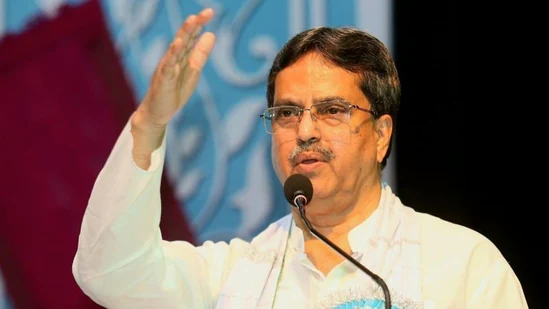
Tripura Chief Minister Dr. Manik Saha on Friday launched the ‘Tripura School Quality Assessment and Accreditation Framework (TSQAAF),’ a state-level mechanism aimed at standardising and evaluating school performance to align with national quality benchmarks.
Speaking at the launch event at Rabindra Shatabarshiki Bhavan in Agartala, Dr. Saha, who also holds the Education portfolio, emphasised that while academic knowledge is essential, it must be accompanied by values, social awareness, and holistic development.
“Textbook education can never be the standard of life,” the Chief Minister stated, adding, “Along with education, children should also be engaged in social work.”
The TSQAAF is expected to serve as an evaluative framework that not only sets indicators for school infrastructure, teaching practices, and learning outcomes but also focuses on co-curricular and value-based education. According to officials, the framework will allow schools across Tripura to be assessed, accredited, and guided for improvement on measurable parameters of quality.
Saha acknowledged that the state education department is adapting to the evolving needs of learners and aligning with national initiatives like the National Education Policy (NEP) 2020. He highlighted the importance of uniformity in curriculum and assessment to ensure students across India are prepared for central-level competition.
“If there is a uniform question paper, our children can also compete centrally,” he said.
The CM also spoke about the broader responsibilities of teachers in shaping character, ethics, and social consciousness among students. He encouraged the inclusion of practical subjects that address social problems and life skills, going beyond syllabus-bound instruction.
Reaffirming the state’s commitment to education reforms, Saha said quality teachers are being recruited through the Teacher Eligibility Test (TET), and more appointments are planned to strengthen the system further.
Senior officials, including Special Secretary of the Education Department Raval Hemendra Kumar, Director of Education N C Sharma, and SBI Foundation CEO Sanjay Prakash, were present at the event. The SBI Foundation has also extended support to the state’s education initiatives.
The TSQAAF initiative marks another step in Tripura’s education reform roadmap, aimed at creating a comprehensive schooling environment that prepares students for academic success while also cultivating civic responsibility.
Education
“We Sleep on Walls Here”: Shubhanshu Shukla Talks to Indian Students from Space
Published
5 days agoon
July 4, 2025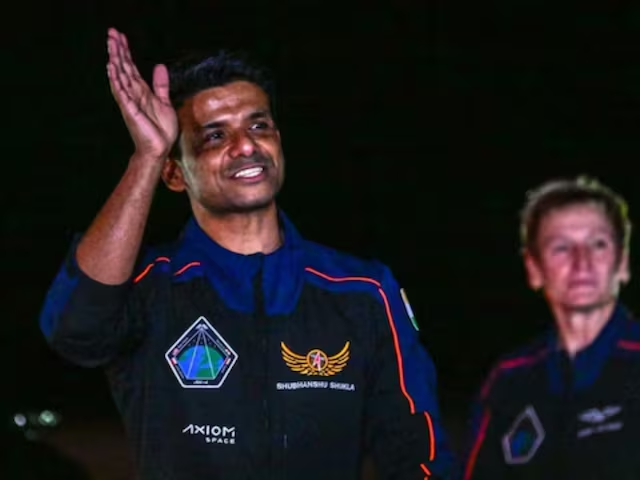
Astronaut Shubhanshu Shukla, currently stationed aboard the International Space Station (ISS), answered questions from schoolchildren during a live interaction hosted under ISRO’s Vidyarthi Samvad Program.
The session, designed to bring students closer to the realities of space science, turned into a heartwarming and humorous conversation about food, sleep, and the sheer wonder of viewing Earth from space.
When asked how astronauts sleep in zero gravity, Shukla smiled and explained: “There is no floor or ceiling in space. Some of us sleep on the wall, some on the ceiling. We have to tie ourselves down so we don’t float away while sleeping.”
The conversation became sweeter when Shukla revealed that he brought familiar Indian flavours with him into orbit. “I have carried gajar ka halwa, moong dal halwa, and mango juice with me from India,” he said, to the delight of the young audience. He clarified that the halwa was specially medicated for space missions, not made at home — a detail that sparked laughter and curiosity alike.
The astronaut also spoke about daily life aboard the ISS, including how exercise is essential to counter microgravity. “We ride bicycles here, but there are no seats. We strap ourselves in with belts,” he told the children, who were both fascinated and amused by the image.
For Shukla, however, the highlight of being in space remains the view of Earth. “That blue sphere, that light mist… seeing Earth from here is the most beautiful experience. It’s hard to describe in words.”
Addressing mental well-being, he shared how astronauts stay connected with their families. “Technology helps bridge the distance. We can talk to our loved ones, and that keeps us grounded — even when we’re not.”
Also present during the interaction was Group Captain Angad Pratap, a fellow member of the Gaganyaan mission crew, who encouraged students to consider careers in aviation and space science.
For many students, the session was a dream come true. “It felt like science fiction,” said one participant. “Now I believe I can go to space one day.”
As India continues its rapid progress in space exploration, conversations like these serve as reminders that inspiration is as critical as infrastructure — and that sometimes, a simple chat with an astronaut can launch the imagination of an entire generation.
Education
A Structural Proposal to Transform School Education in Bihar
Published
5 days agoon
July 4, 2025
In a recent public interaction, political campaigner and policy strategist Prashant Kishor detailed a long-term education plan aimed at overhauling Bihar’s school system. Emphasizing structural change over symbolic efforts, Kishor’s proposal focuses on centralized excellence, increased parental choice, and a phased financial roadmap over a 10-year period.
At the heart of the model lies a shift from quantity to quality. Rather than building one school in every village, the plan envisions five world-class government schools per administrative block, inspired by the legacy of the prestigious Netarhat Vidyalaya. These institutions would be open to students from all socioeconomic backgrounds, with Kishor stating that school buses and transport access would ensure that no child travels more than 20 minutes to reach school.
For families dissatisfied with local government schools, the model introduces an alternative: state-funded access to private education. If a student opts for a regulated private school nearby, the government would bear the cost. According to Kishor, this mirrors global best practices and provides an immediate quality option while public school infrastructure is being upgraded.
Contrary to the common belief that government education is cost-free, Kishor highlighted that Bihar currently spends an average of ₹850 per month per child in public primary schools. In comparison, many private institutions operate at a lower cost. “It’s not about public versus private. It’s about outcomes and value,” he stated.
The financing strategy involves a three-part allocation of the current education budget:
-
Building new elite schools (500 per year; 5,000 in 10 years)
-
Improving existing government schools
-
Funding private education for low-income students where needed
The total projected investment over a decade is ₹1 lakh crore.
The proposal has triggered a wider conversation around efficiency, equity, and the future direction of school education in under-resourced states. While it has been shared in a pre-election context, the structural detail and comparative lens make it notable for educationists and policymakers nationwide.
As the national education landscape continues to evolve post-NEP 2020, Bihar’s unfolding discourse offers a compelling case study on scalable, outcome-driven reform.
Education
NIIT Foundation and YuWaah, UNICEF Launch Free Online Digital Marketing Course for Youth
Published
5 days agoon
July 4, 2025
In a bid to support youth skilling in India, NIIT Foundation and YuWaah (a UNICEF India initiative) have jointly launched an Open Online Course in Digital Marketing as part of their #NayiDigitalDisha campaign.
The initiative has been rolled out in Rajasthan, Jharkhand, and Odisha and aims to reach 500 participants. The 8-week online program has been structured to be accessible to learners from underserved and remote areas. Upon completion, students will receive a credential assessed by NCVET and certified by NSDC.
The curriculum focuses on practical digital marketing skills including social media strategy, online customer sourcing, and campaign execution. Course development was led by NIIT Foundation, drawing on industry consultation and its prior experience in skill training.
According to the organisers, the goal is to provide industry-aligned learning opportunities to help learners secure employment and enhance their readiness for digital roles. Participants will receive certifications from both NIIT Foundation and YuWaah, UNICEF.
The program’s implementation coincides with India’s broader push towards a skilled workforce, aligning with national goals to build digital and job-readiness capacity by 2047. The digital learning initiative is part of a larger ecosystem supported by YuWaah that includes career guidance, leadership opportunities, and pathways to socio-economic participation for young people.
Earlier success stories, such as a student securing job placements after course completion, indicate emerging results; however, the course’s full impact is yet to be assessed as it progresses through its first implementation cycle.
Education
National Conference Pushes for Common Standards Across School Boards
Published
5 days agoon
July 4, 2025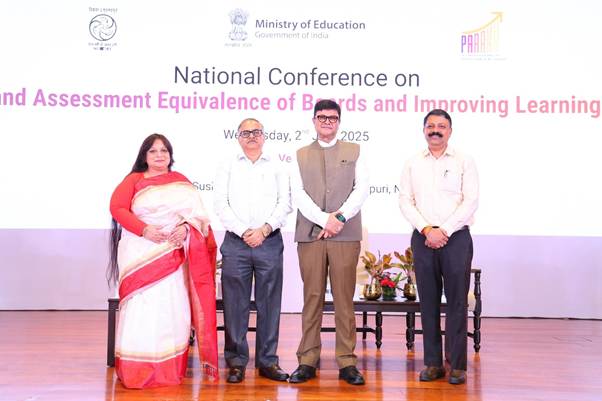
In a move set to impact India’s school education ecosystem, the Department of School Education and Literacy (DoSE&L), Ministry of Education, convened a high-level National Conference on Curricular and Assessment Equivalence of Boards and Improving Learning Outcomes at Sushma Swaraj Bhawan, New Delhi.
With over 250 senior officials from education departments, boards, SCERTs, and autonomous bodies like CBSE, KVS, and NVS, the conference reflected a coordinated push to align learning outcomes and assessment standards across India’s diverse schooling systems.
Chaired by DoSE&L Secretary Sanjay Kumar, the sessions explored how India can move toward competency-based education while ensuring fairness and flexibility for States/UTs. He emphasised that equivalence in curriculum and assessments is essential as India modernises its academic benchmarks in line with NEP 2020.
A key highlight was the launch of the PARAKH Rashtriya Sarvekshan Dissemination Portal, giving open access to national and state-wise data on student performance. The tool is designed to help States/UTs craft targeted improvement plans.
Prof. Indrani Bhaduri, CEO of PARAKH, also unveiled the findings from the 2024 National Survey, highlighting district-wise variations and prompting calls for data-driven, localised reform.
Best practices from six States/UTs — including Kerala, Punjab, UP, and Maharashtra — offered a practical lens on how systemic innovations can drive classroom-level change.
The conference also delved into board equivalence frameworks, with seven State Boards — including Andhra Pradesh, Assam, Goa, and J&K — presenting models for alignment of curricula, assessments, and evaluation standards.
CBSE Chairperson Rahul Singh spoke on school quality assurance, urging emphasis on self-evaluation and data transparency.
The conference spotlighted the School Quality Assessment and Assurance Framework (SQAAF) and called for the establishment of State School Standards Authorities (SSSA) in every State/UT.
Further, the session on vocational education equivalence underscored the importance of recognising school boards as vocational awarding bodies — a step towards seamless academic–skill integration and lifelong learning.
Ready Reckoner videos, Holistic Progress Cards (HPCs), and tools for continuous, child-centric evaluation were also introduced, aimed at embedding NEP’s vision in day-to-day school practice.
The event concluded with a collective reaffirmation: building an equitable, high-quality education system will require collaborative governance and commitment to learning for all.
Newsletter

UP Govt Launches Astro Labs in Government Schools to Boost Scientific Learning

Class 3 Learning Levels Show Gains Since Pandemic, But Still Below 2017: PARAKH Survey

Design and the Future of Learning: How Architecture is Shaping Next-Gen Schools

Punjab to Introduce Business, Marketing Education in Govt Schools for High Schoolers

Manipur Rallies Call for Disruption-Free Education Amid Ongoing Unrest

Tripura CM Launches School Framework, Stresses Social Work in Education

“We Sleep on Walls Here”: Shubhanshu Shukla Talks to Indian Students from Space

A Structural Proposal to Transform School Education in Bihar

NIIT Foundation and YuWaah, UNICEF Launch Free Online Digital Marketing Course for Youth

National Conference Pushes for Common Standards Across School Boards

Maharashtra: Over 8,000 Villages Lack Schools, CCTV Compliance Still Patchy

Haryana to Offer Free After-School Coaching for JEE, NDA Aspirants

Telangana CM Calls for Overhaul of Intermediate Education in Telangana

Indian Astronaut Shubhanshu Shukla to Connect with School Students Live from Space

Are 4-Year Degrees Dead? Nikhil Kamath and the WEF Say Lifelong Learning Is Here to Stay

UGC Cracks Down on 89 Institutes Over Anti-Ragging Failures

Government Doubles Down on Coaching Centres: New Panel Signals Stronger Regulation Ahead

CBSE To Conduct Board Exams Twice for Class 10 from 2026

How to Win Back Wandering Minds: Post-Summer Edition
Tripura Becomes Third Indian State to Achieve Full Literacy

Assam Brings Sign Language to Senior Secondary Classrooms in Landmark Move

Delhi Schools to Implement Age 6 Rule for Class 1 Admissions from 2026

Tripura Adds Sex Education & HIV Awareness to Their Curriculum

Four Indian Schools Shine on the Global Stage at World’s Best School Prizes 2024

Centre Urges 7 States to Consider Common Board Amid Alarming Student Failure Rates

Is Your School Following These Mandatory CBSE Committees?

CBSE’s ‘Sugar Boards’ Initiative: Tackling the Sweet Crisis in Indian Schools

Maharashtra to Regulate Pre-Primary Education with New Law Aligned to NEP 2020

MAHAJYOTI’s Book Distribution Scheme to Empower 7,000 OBC Students Preparing for JEE/NEET & MHT-CET

China Embarks on Ambitious AI-Driven Education Reform to Build a ‘Strong Education Nation’ by 2035

John King’s Book ‘Teacher By Teacher’: A Global Tribute to the Transformative Power of Education

CBSE Introduces Mandatory Bridge Course for Classes 6 to 12 in Chhattisgarh Under NEP 2020

Rewriting Ambedkar: Why Students Must Know the Man Beyond the Constitution

CBSE Mandates 50-Hour Annual Training for Teachers, Declares STEM as 2025 Theme

Banu Mushtaq’s International Booker Win Is a Wake-Up Call for Indian Schools to Reclaim Literature

India Bids Farewell to NEP Architect Dr K. Kasturirangan

Pradhan Mantri Rashtriya Bal Puraskar 2025: Nominations Now Open for India’s Young Achievers

NCERT Class 7 Textbooks Updated: Mughals Removed, Focus on Indian Ethos and Pilgrimage

Delhi Government Cracks Down on Dummy Schooling; Over 600 Schools Inspected, 10 Issued Notices

Delhi Approves Landmark Bill to Regulate School Fees Across 1,677 Institutions

Operation Sindoor and Operation Abhyaas: Navigating School Safety and Student Well-being Amid Rising Tensions

Harvard Stands Its Ground: Harvard Faces ₹18,400 Crore Funding Freeze After Rejecting Trump Administration’s Demands
CBSE Revises Class 10, 12 Curriculum: Biannual Exams, New Subjects and Flexible Passing Criteria Introduced

CUET-UG 2025 Likely to be Postponed, Fresh Dates Expected Soon

Aalamaram 2025: Where Indian Educators Came Together to Grow, Reflect, and Lead

Trump Signs Executive Order to Promote AI Integration in U.S. K-12 Education

Mizoram Declared First Fully Literate State in India

Indian Students Flock to Singapore, Ireland, and Dubai for Higher Studies: 38% Surge Recorded

UK’s New Immigration Rules: What They Mean for Indian Students

OpenAI Academy Launches in India to Democratise AI Education for Students, Teachers, and Startups
SGEF2023 | Special Address by Rama Datt, Trustee, Maharaja Sawai Man Singh II Trust, Jaipur

ScooNews | After Movie | ScooNews Global Educators Fest 2023

Aftermovie | NIES2 UP Chapter | 21 Jan 2023

WEBINAR | Gamification in Education: How Digital Badges Can Boost Student Motivation and Engagement

ScooNews | WEBINAR| Importance of Physical Activity for Children at School | Plaeto

SCOONEWS | WEBINAR | WHY DIGITIZING YOUR SCHOOL IS A MUST | TEACHMINT

Keynote Address | Lakshyaraj Singh Mewar

Anurag Tripathi, Secretary, CBSE at SGEF2022

How schools can nurture every student’s genius

Aftermovie | SGEF2022 | Jaipur

Li Andersson | Minister of Education | Finland

Anurag Tripathi, Secretary, Central Board of Secondary Education (CBSE) discusses NEP2020

ScooNews | Early Ed Asia 2019 | Aftermovie
#PodarECEconf : Pursuing quality ECE

#CBSE Class XII #Results #Highlights

The interesting story of India’s educational system | Adhitya Iyer

A young scientist’s quest for clean water

The Danger of Silence: Clint Smith

National Digital Library of India is an initiative by HRD Ministry

Remembering Kalpana Chawla on her birthday!

Message from Sadhguru for Students!
Message from Sadhguru for Students!

The Untapped Genius That Could Change Science for the Better

Eddy Zhong: How school makes kids less intelligent TEDxYouth@Beacon

#TEDxCanberra : What if every child had access to music education…
Trending
-
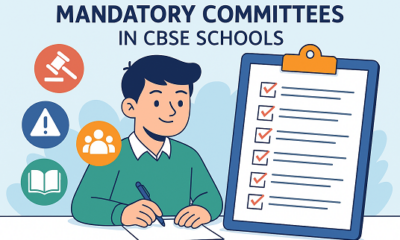
 Education3 months ago
Education3 months agoIs Your School Following These Mandatory CBSE Committees?
-

 Education2 months ago
Education2 months agoCBSE’s ‘Sugar Boards’ Initiative: Tackling the Sweet Crisis in Indian Schools
-
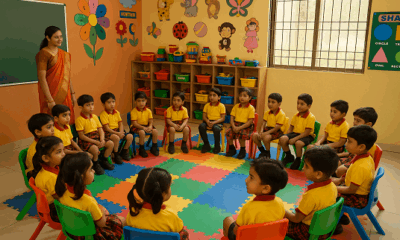
 Education3 months ago
Education3 months agoMaharashtra to Regulate Pre-Primary Education with New Law Aligned to NEP 2020
-

 Education3 months ago
Education3 months agoMAHAJYOTI’s Book Distribution Scheme to Empower 7,000 OBC Students Preparing for JEE/NEET & MHT-CET
-
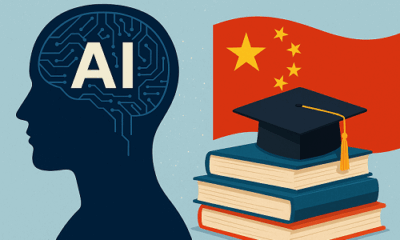
 Education3 months ago
Education3 months agoChina Embarks on Ambitious AI-Driven Education Reform to Build a ‘Strong Education Nation’ by 2035
-
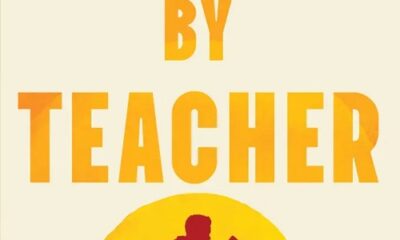
 Education2 months ago
Education2 months agoJohn King’s Book ‘Teacher By Teacher’: A Global Tribute to the Transformative Power of Education
-
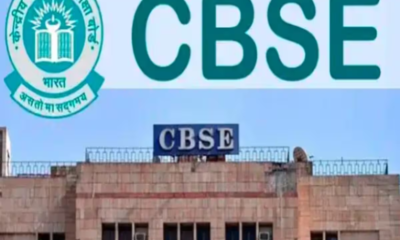
 Education3 months ago
Education3 months agoCBSE Introduces Mandatory Bridge Course for Classes 6 to 12 in Chhattisgarh Under NEP 2020
-
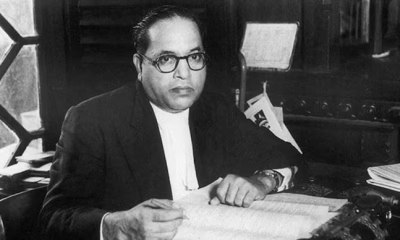
 Education3 months ago
Education3 months agoRewriting Ambedkar: Why Students Must Know the Man Beyond the Constitution
-
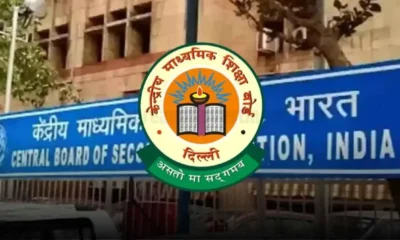
 Education3 months ago
Education3 months agoCBSE Mandates 50-Hour Annual Training for Teachers, Declares STEM as 2025 Theme
-
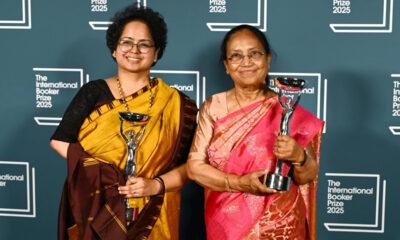
 Education2 months ago
Education2 months agoBanu Mushtaq’s International Booker Win Is a Wake-Up Call for Indian Schools to Reclaim Literature





